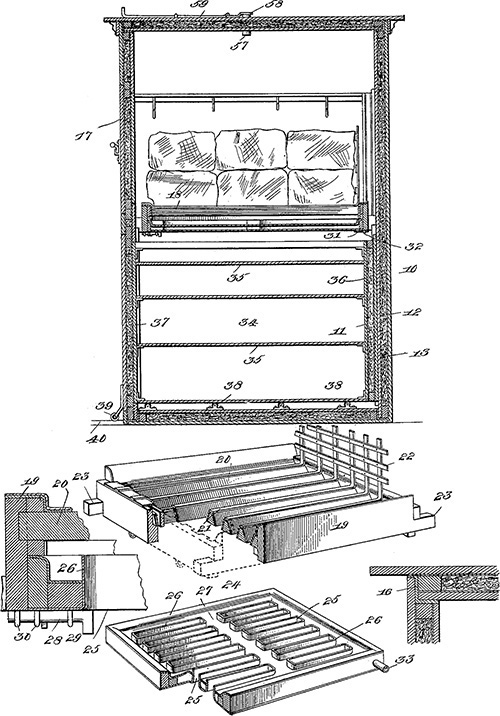3. Slap an Interface on It!: Slimmer TVs! Faster computers! And an overlooked epidemic of awful.
You can’t write a tech book today without giving credit to us. It truly is impressive what we’ve done as a society—teachers to venture capitalists—to push important technology forward.
Good job, everyone.
Let’s say we filled your entire hard drive with high-definition movies. The dot below represents how many movies you could have stored on the largest hard drive you could buy in 2006:

About 180 movies (4GB movies on a 750GB hard drive)
Seven years later, on the largest hard drive available, you could store enough movies to watch them for 125 days straight.

About 1,500 movies (4GB movies on a 6,144GB hard drive)
Imagine the black background on this page represents the percentage of American adults who had access to fast, broadband Internet speeds in 2000.

The black on this page is how many had access to broadband speeds about ten years later.

There’s really so much to celebrate in technology today. We’ve created materials that reduce the sun’s glare. Really. We’ve made screens that have greater clarity than ink on paper. We’ve not only built a really useful Internet but made it available across almost the entire world at really fast speeds in the palm of our hands. It’s kind of ridiculously amazing how awesome we are.
Our list of technological achievements is long, but an awful trend is emerging. A growing epidemic in the way experiences with technology are built.
I’m a user experience (UX) designer. That means my job is to understand your common, everyday problems and to use technology to solve them. I’ve worked at an innovation lab for Zappos, where I helped design and imagine the future of how a customer service company could solve customer problems. I’ve worked at a Samsung innovation lab, where I helped design and imagine new services and consumer electronics to solve people’s problems. And I worked at Cooper, a design consultancy where we solved everyday problems for our clients’ customers.
My job is to solve people’s problems, but as an industry we’ve gotten away from solving people’s problems. As an industry, we’ve gotten caught up in a globally evident technological impotence of me-too thinking that is taking us away from real innovation.
1. BioCon Valley, 2. Bit Valley, 3. Brazilian Silicon Valley, 4. CFK Valley, 5. Cwm Silicon, 6. Cyber District, 7. Cyberabad, 8. Dallas-Fort Worth Silicon Prairie, 9. Dubai Silicon Oasis, 10. Etna Valley, 11. Food Valley, 12. Health Valley, 13. Illinois Silicon Prairie, 14. Isar Valley, 15. Lima Valley, 16. Measurement Valley, 17. Medical Valley, 18. Mexican Silicon Valley/Silicon Valley South, 19. Midwest Silicon Prairie, 20. Philicon Valley, 21. Russian Silicon Valley, 22. Silicon Allee, 23. Silicon Alley, 24. Silicon Anchor, 25. Silicon Beach, 26. Silicon Border, 27. Silicon Bridge, 28. Silicon Canal, 29. Silicon Canal, 30. Silicon Cape, 31. Silicon Coast, 32. Silicon Corridor, 33. Silicon Desert, 34. Silicon Dock, 35. Silicon Docks, 36. Silicon Fen, 37. Silicon Forest, 38. Silicon Glen, 39. Silicon Goli, 40. Silicon Gorge, 41. Silicon Gulf, 42. Silicon Harbor, 43. Silicon Hill, 44. Silicon Hills, 45. Silicon Lagoon, 46. Silicon Lane, 47. Silicon Mall, 48. Silicon Mallee, 49. Silicon Mill, 50. Silicon Peninsula, 51. Silicon Pier, 52. Silicon Roundabout, 53. Silicon Sandbar, 54. Silicon Savannah, 55. Silicon Saxony, 56. Silicon Sentier, 57. Silicon Shipyard, 58. Silicon Shire, 59. Silicon Shore, 60. Silicon Sloboda, 61. Silicon Slopes, 62. Silicon Spa, 63. Silicon St, 64. Silicon Surf, 65. Silicon Swamp, 66. Silicon Taiga, 67. Silicon Valley, 68. Silicon Valley of China, 69. Silicon Valley of India, 70. Silicon Valley of Indonesia, 71. Silicon Valley of South Korea, 72. Silicon Valley of Taiwan, 73. Silicon Valley North, 74. Silicon Vineyard, 75. Silicon Wadi, 76. Silicon Walk, 77. Silicon Welly, 78. Silicon Woods, 79. Silicotton Valley, 80. Solar Valley, 81. Ticino Valley Area, 82. Wyoming Silicon Prairie (also called the Silicon Range)
Oh, the unoriginal places you’ll go.
Guy Kawasaki, formerly an advisor for Google and Apple, once gave these words of advice: “There’s one more thing you need to do: Aim higher than merely trying to recreate Silicon Valley. You should try to kick our butt instead.”1
Many brilliant thinkers, dreamers, designers, engineers, developers, and entrepreneurs have made and will continue to make great strides enriching the human experience through technology in many of these locations. But in an ultracompetitive global market where fast and lean are more valued than deep thinking or original solutions, many of us—including myself—have been caught up in reactionary rectangles, thoughtless habits, and the self-delusion that the way things have gone the past few years is the way we should keep going forever.
Put yourself in the mind of an “innovative” company, and let’s play a game.
Q: HOW DO YOU MAKE A BETTER CAR?
Above, is one of the earliest patent drawings for an automobile. The technologists of the day solved a real problem with transportation. And as a result, the car changed the way we live. The way our cities are built. Who and what we can see, and when and where we can see them.
So today, utilizing the amazing technological progress we’ve made in the over one hundred years since, what technique have modern technologists used to improve the car?
A: SLAP AN INTERFACE ON IT!
Who would need to look at the road while driving? Leaning over to touch a screen is so much more fun.
Telsa’s one of the most innovative companies in the world—that’s why they’ve got a seventeen-inch touchscreen center console. Sure, there are haters. Some lost soul at The Verge wrote, “I don’t want a web browser in my car, and more importantly, I don’t want the drivers around me to have one.”1 But consider scrollbars in your center console. I know. Amazing.
Among the many wonderful options for screens in your car, there’s BMW’s Mini model with a screen in the middle of the speedometer that—yes, really—lets you check your Twitter and Facebook instead of focusing on how fast you’re driving.2
Driving is about the road? Nah, it’s about screens, brah.
Q: HOW DO YOU MAKE A BETTER FRIDGE?
Above is one of the earliest patent drawings for a refrigerator. The technologists of the day solved an important problem: keeping our food fresh. And it goes without saying, the refrigerator also changed the way we live. Domestic and international food distribution has changed enormously thanks to the refrigerator, and fresher and healthier choices are now more readily available to more people thanks to innovations that came from drawings like this.
A: SLAP AN INTERFACE ON IT!
Yes! This is where I want to look through my photo albums. Other manufacturers offer fantastic features like updating our Evernote when we go to get ice.3 Or listening to Pandora from the refrigerator door. With the most wonderful refrigerator models today we can, obviously, update Facebook and Twitter above the ice dispenser.4
Q: HOW DO YOU MAKE A BETTER TRASH CAN?
A: SLAP AN INTERFACE ON IT!
Hope you got this obvious one: You can make a better trash can by turning it into a $47,000 LCD recycling bin, so that you can see if it’s raining outside when you’re standing outside in the rain. One hundred of these incredible bins were installed in London just before the 2012 Olympic Games to help the city show off its futuristic wonders.5 And why not? Screens are so futuristic.
Q: HOW DO YOU MAKE A BETTER RESTAURANT?
A: SLAP AN INTERFACE ON IT!
Finally. I’m so sick of talking to people.
Customer service saviors like Chili’s and Applebee’s have installed these kinds of touch-screen ordering systems in thousands of restarants across the country to replace frightening conversations with another person. A Chili’s senior vice president once told the Wall Street Journal that the interfaces get more people to buy more stuff—like coffee and desserts that flash on the screen.6 That’s obviously a great thing for America’s diet. And since I’m basically just staring at my phone the whole time while dining with my friends anyways, what’s the harm of another screen on the table?
Q: HOW DO YOU MAKE A BETTER VENDING MACHINE?
A: SLAP AN INTERFACE ON IT!
Thank you! I hate seeing the product I’m about to buy through clear glass.
That’s why companies like Coca-Cola and Pepsi are working on touch interfaces so that you can order your favorite drinks through a series of menus and error messages. As USA Today wrote of Coca-Cola’s efforts, “This teen-targeting, touch-screen dispenser flavors self-created beverages in micro-doses. It may be Coke’s best hope to keep Millennials fully engaged, socially involved and buying fizzy drinks at a time industry sales are falling faster than water down the drain.”7
Duh. Touchscreens are totally going to help sales.












